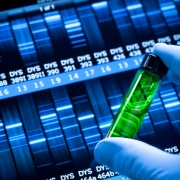Cancer IVD: 4 Trends to Watch in $5.5 Billion Market
Whether affecting the lungs, colorectal system, stomach, liver, breasts, or other parts of the body, few medical maladies carry the inherent gravitas of cancer. Annually, millions of new cancer cases are diagnosed and millions of cancer linked deaths occur worldwide. Undoubtedly, cancer poses one of the greatest threats to human health globally.
This proliferating cancer threat is boosting world demand and growth opportunities for specific, sensitive tests, as well as precision medicine and companion diagnostics for treating cancer. As a result, the cancer in vitro diagnostics (IVD) market is valued at $5,535 million* ($5.5 billion) in 2021, including the demand for companion assays, according to World Market for Cancer Diagnostics, a new report by leading medical market research publisher Kalorama Information.
“The urgent need to improve the outcome of patients with various forms of cancer is boosting opportunities for new and existing tests that help detect tumors early, determine disease risk, identify and assess the effectiveness of therapies, and assist in the discovery and commercialization of new improved anti-cancer agents.”
World Market for Cancer Diagnostics identifies several significant trends occurring in the cancer IVD market currently, spanning a range of aspects and subjects from technology trends to regulatory trends. Among the key trends related to the cancer IVD market are:
1) Pharmacodiagnostic Tests: The ongoing introduction of targeted and cytotoxic cancer drugs, coupled with intensified efforts to improve the efficacy and control the cost of oncological therapy, will underlie gains in pharmacogenetic testing. Advances in liquid biopsy techniques will also contribute to growth by enabling tumor cells to be extracted more easily.
Pharmacodiagnostic products consist of predictive tests, which are implemented to determine whether a patient is expected to respond to a given therapy. The development of molecular tests for the personalization of cancer treatment in this area is still far from complete. Every cancer has a unique genomic aberration pattern that is associated with distinct prognostic and therapeutic characteristics. Researchers have begun to examine the potential of next-generation DNA sequencing for a deeper genetic understanding of tumor activities, which is expected to serve as the foundation for developing more effective ways to diagnose cancer.
2) Liquid Biopsy-based Non-Invasive Cancer Molecular Diagnostics: Liquid biopsies are blood-based molecular tumor assays, which have been on the market for several years. However, until recently, they have not been aggressively pursued for a centralized role in cancer detection, characterization, and staging. Numerous markers for hematological cancer or cancer-related genomic DNA found in blood cells have been assayed. Among the commercial tests based on these markers are JAK2, BCR-ABL and PML-RARA gene mutation and fusion detection kits and quantitative PCR kits for transcript-based disease monitoring.
For the next several years, the liquid biopsy market is expected to be driven primarily by tests that detect mutations significant to targeted therapy selection. The technology holds the potential to develop into a leading method of asymptomatic cancer detection and tumor monitoring, but first must overcome significant technical challenges. The main challenge involves determining the threshold for circulating tumor DNA (ctDNA) quantities between early onset cancer requiring intervention and non-lethal cancers or malignant cells that can be managed by the patient’s immune system. In addition, the sensitivity of detecting cell-free DNA (cfDNA) in next-generation sequencing (NGS) assays requires substantial improvement.
Liquid biopsy in its current format is used primarily in the treatment of lung, melanoma, breast, ovarian, cervical, and bladder cancers. But most tests have yet to prove their clinical utility. Although the technology has been investigated since 2004 it is still regarded with some skepticism. Ultimately, quality control of the test process and sampling are essential to the routine adoption of liquid biopsy for cancer and also emerging medical disciplines.
3) Circulating Tumor Cell (CTC) Tests: Global demand for circulating tumor cell (CTC) testing products is projected to rise 6% annually through 2026. Advances in liquid biopsy technologies will foster growth by expanding the number of tumor cells that can be readily extracted for analysis. Less invasive advantages over alternative tissue-based pathology procedures will also contribute to gains.
Circulating tumor cells analyzed through flow cytometry account for approximately 200,000 global procedures annually. Flow cytometry is an IVD technology that rapidly identifies, classifies, and differentiates cells in a fluid suspension. Circulating tumor cells are cells that detach from a primary tumor and circulate throughout the bloodstream. These cells are part of the metastasizing process that leads to the progression of cancer and therefore represent a valuable test for early diagnosis. It is widely believed that detection of CTCs in the blood is key to monitoring an individual’s baseline condition and ongoing response to therapy, the theory being that CTCs act as seeds for subsequent growth of additional tumors in tissues distant from the original source.
4) Artificial Intelligence: Clinical scoring systems and algorithms have been used in medical practice for some time, recently there has been an increase in the application of machine learning (artificial intelligence) to improve these tools. While traditional algorithms require all calculations to be pre-programmed, machine-learning algorithms deduce the optimal set of calculations by searching for patterns in large collections of patient data. New applications of AI are in development to predict outcomes such as diagnosis, death or hospital readmission; improve upon standard risk assessment tools; elucidate factors that contribute to disease progression; or to advance personalized medicine by predicting a patient’s response to treatment.
Oncology faces two major challenges: detecting cancers when they are small and easier to treat and offering cancer patients personalized targeted cancer care. The use of machine learned algorithms are a perfect complement to liquid biopsy that aims to answer the challenge by detecting cell free and tumor DNA in the sea of a patient’s peripheral blood. A liquid biopsy test can detect traces of DNA, the meaning of, which are not always obvious to the oncologist. Since all tumors are unique, liquid biopsy methods have yet to accurately detect most cancers with absolute certainty.
Further, many cancers lack a simple set of known mutations that can identify the tumor and so determine the best treatment option. Also, the development of the analysis of tumor DNA and circulating tumor cells with sequencing techniques produces a large amount of test data, some of which is not generally associated with the tumor site in question. This is where machine learning comes into the picture.
For more information on these and other trends, purchase World Market for Cancer Diagnostics at https://kaloramainformation.com/product/world-market-for-cancer-diagnostics/.
* Note: Kalorama Information’s IVD market estimate includes test kits, reagents and instrumentation used to perform tests for cancer diagnosis and prognosis. It does not encompass the value of test services. However, it includes the sales of reagents and instruments used to perform lab testing services or lab developed tests (LDTs) for cancer.




